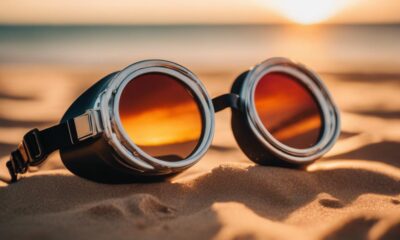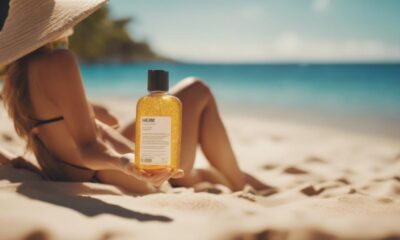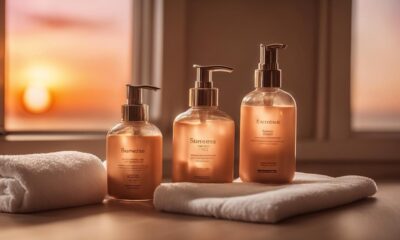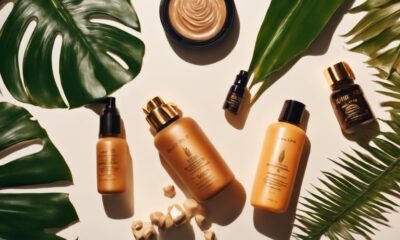Sun Protection
Is Your Sunscreen Really Protecting You? Find Out Now!
Maximize your sun protection with the right sunscreen—discover what you might be missing to truly shield your skin from harm!

Your sunscreen might not be protecting you as well as you think. Many people apply it incorrectly or forget to reapply, which can leave your skin vulnerable. Look for a broad-spectrum formula with at least SPF 30 to shield against both UVA and UVB rays. Check the ingredients and avoid harmful chemicals like oxybenzone. Don't forget to apply about one ounce to all exposed skin 15-30 minutes before going outside and reapply every two hours. Curious about how to maximize your sunscreen's effectiveness? There's a lot more to uncover about ensuring you're truly protected from the sun.
Key Takeaways
- Ensure your sunscreen is labeled "broad-spectrum" to protect against both UVA and UVB rays for optimal skin safety.
- Check for SPF 30 or higher to block a significant percentage of UVB rays, enhancing protection against sunburn and skin cancer.
- Apply sunscreen 15-30 minutes before sun exposure and reapply every 2 hours, especially after swimming or sweating.
- Review ingredient lists to avoid harmful chemicals like oxybenzone and prioritize safer mineral-based sunscreens for sensitive skin.
Understanding Sunscreen Ingredients
When choosing a sunscreen, it's essential to understand the difference between physical and chemical ingredients and how they protect your skin from harmful UV rays.
Physical blockers, like zinc oxide and titanium dioxide, work by sitting on your skin's surface to reflect and scatter UVA and UVB rays. They provide immediate protection upon application, making them a reliable option for quick sun exposure.
On the other hand, chemical blockers such as oxybenzone and avobenzone absorb UV radiation and convert it into heat, which your skin then releases. However, these typically require about 20 minutes to become effective.
For peak protection, look for a broad-spectrum sunscreen with at least SPF 30. This guarantees you're shielded against both types of UV rays, reducing your risk of skin cancer.
It's also important to be cautious of potentially harmful ingredients. Some, like retinyl palmitate, have been linked to increased skin tumor risks in studies, while methylisothiazolinone can cause allergic reactions.
The Importance of SPF

Understanding sunscreen ingredients sets the stage for appreciating the importance of SPF in protecting your skin from UV damage. SPF, or Sun Protection Factor, is vital because it measures a sunscreen's ability to block harmful UVB rays that can lead to sun damage and skin cancer. To guarantee effective protection, dermatologists recommend using a broad-spectrum sunscreen with at least SPF 30.
Here's a quick look at how different SPF levels compare:
| SPF Level | UVB Protection | Notes |
|---|---|---|
| SPF 30 | ~97% | Minimum recommended |
| SPF 50 | ~98% | Higher but less effective gain |
| SPF 100 | ~99% | Diminishing returns |
| Water-Resistant | 40-80 minutes | Important for active lifestyles |
| Reapply | Every 2 hours | Essential for continued protection |
Broad-Spectrum Protection Explained

When choosing sunscreen, it's essential to understand the importance of broad-spectrum protection.
This means your sunscreen should guard against both UVA and UVB rays, which can lead to skin aging and sunburn, respectively.
Let's explore how to select effective sunscreens that truly protect your skin.
Importance of Broad-Spectrum Protection
Broad-spectrum protection is vital for safeguarding your skin against the harmful effects of both UVA and UVB rays. These rays contribute to skin cancer and photoaging, making it important to choose the right sunscreen. The American Academy of Dermatology recommends using broad-spectrum sunscreen with an SPF of at least 30 to guarantee effective protection.
Here's a breakdown of the importance of broad-spectrum protection:
| Aspect | Importance |
|---|---|
| UVA Rays | Penetrate deeper, causing skin cancer risk |
| UVB Rays | Responsible for sunburn |
| SPF 30+ | Recommended level for sufficient protection |
| Regular Use | Can reduce skin cancer risk by up to 50% |
Choosing a broad-spectrum sunscreen guarantees you're protected from both types of UV radiation. Products labeled as “broad-spectrum” have been tested to provide extensive protective benefits. Regularly applying this kind of sunscreen not only helps prevent skin cancer but also combats the signs of photoaging. Prioritize your skin health by selecting a broad-spectrum sunscreen to enjoy the sun safely.
Understanding UVA and UVB
UVA and UVB rays pose different threats to your skin, making it essential to know how each affects your health.
UVA rays penetrate deeper, leading to skin aging and increasing your risk of skin cancer. On the other hand, UVB rays primarily cause sunburn and trigger skin cancer development, making both types of radiation a concern.
To protect yourself effectively, use a broad-spectrum sunscreen that guards against both UVA and UVB rays.
The American Academy of Dermatology recommends a broad-spectrum sunscreen with an SPF of at least 30 to block about 97% of UVB rays. For UVA protection, look for a PA rating of PA+++ or PA++++ for better defense.
Choosing Effective Sunscreens
Selecting the right sunscreen is essential for safeguarding your skin from harmful UV rays. To guarantee you're fully protected, look for broad-spectrum options that guard against both UVA and UVB rays.
Here are three key factors to take into account when choosing an effective sunscreen:
- SPF Rating: Always opt for a sunscreen with at least SPF 30. It filters about 97% of UVB rays, while SPF 50 blocks around 98%. This slight difference can be significant in sun protection.
- Water-Resistant Formula: If you're swimming or sweating, choose a water-resistant sunscreen, which lasts either 40 or 80 minutes in water. This guarantees continuous protection during your activities.
- Sensitive Skin Considerations: If you have sensitive skin, look for sunscreens with PA+++ or PA++++ ratings for strong UVA protection. These formulations can help prevent long-term skin damage.
Remember to apply sunscreen generously and evenly over all exposed skin. Don't forget to reapply every two hours, or more frequently if you're in water or sweating.
Application Techniques for Effectiveness

To guarantee your sunscreen offers the best protection, apply about one ounce, or a shot glass full, to all exposed skin. This shot glass-sized amount guarantees you're applying enough to cover all exposed areas effectively.
It's vital to apply sunscreen 15-30 minutes before heading out to let it bind to your skin. Be certain to focus on even coverage by thoroughly rubbing it in, especially in often-missed spots like your ears, back of the neck, and tops of your feet.
During peak sun hours, typically between 10 AM and 4 PM, reapply sunscreen every two hours to maintain its effectiveness. If you've been swimming, sweating, or towel drying, don't forget to reapply more frequently.
For added protection, consider using a water-resistant sunscreen, which helps keep you protected even when you're in the water.
Common Myths About Sunscreen

Even with proper application techniques, misconceptions about sunscreen can lead to inadequate protection against harmful UV rays. You may believe some common myths that could jeopardize your skin health. Here are three important misconceptions to debunk:
- Cloudy Days Don't Require Sunscreen: Up to 90% of UV rays can penetrate clouds, so daily application is essential, rain or shine.
- A Tan Protects Your Skin: Any tan is a sign of skin damage and increases your risk of developing skin cancer. Don't rely on a tan for protection!
- Darker Skin Doesn't Need Sunscreen: Regardless of your skin tone, UV damage can occur. Regular use of broad-spectrum sunscreen is critical for everyone.
Additionally, relying solely on makeup with SPF may not provide adequate protection. You should apply a layer of traditional sunscreen underneath for best defense.
Evaluating Sunscreen Safety

When evaluating sunscreen safety, it's important to examine the ingredient list for potential harmful components that could affect your health. Some sunscreen ingredients, like oxybenzone and retinyl palmitate, are linked to health risks, and the EWG recommends avoiding them. Instead, consider mineral sunscreens, which use zinc oxide or titanium dioxide to reflect UV rays without the hormonal disruption associated with chemical sunscreens.
To help you assess sunscreen options, here's a quick comparison of key features:
| Sunscreen Type | Common Ingredients | Safety Level |
|---|---|---|
| Chemical Sunscreens | Oxybenzone, Octinoxate | Moderate to Low |
| Mineral Sunscreens | Zinc Oxide, Titanium Dioxide | High |
| Broad-Spectrum | SPF 30+ | Recommended |
| Regular Application | Every 2 hours | Important |
| Additional Protection | Clothing, Shade | Vital |
Using broad-spectrum sunscreen with at least SPF 30 is vital to protect against both UVA and UVB rays and reduce your risk of skin cancer. Remember, regular application enhances your protection, but no sunscreen can block 100% of UV damage.
Types of Sunscreens: Physical Vs. Chemical

Physical and chemical sunscreens differ in their active ingredients and how they protect your skin from harmful UV rays.
Physical sunscreens, containing zinc oxide and titanium dioxide, reflect UV rays away, offering immediate protection. In contrast, chemical sunscreens absorb UV radiation and convert it to heat, taking about 20 minutes to become effective.
When choosing between the two, consider these three key points:
- Sensitive Skin: Mineral (physical) sunscreens are often gentler and better tolerated by those with sensitive skin.
- Hormone Disruption: Some chemical sunscreens, like those containing oxybenzone, raise concerns about being hormone disruptors.
- UV Protection: Both types should be broad-spectrum to shield you against harmful UVA and UVB rays.
Ultimately, it's crucial to select a sunscreen that not only protects your skin effectively but also aligns with your health concerns.
Additional Sun Safety Measures

Incorporating additional sun safety measures can greatly enhance your protection against harmful UV rays. While using broad-spectrum sunscreen is essential, it's not your only line of defense.
Wearing protective clothing, such as wide-brimmed hats and long-sleeved shirts, considerably reduces UV exposure. Opt for sun-protective clothing specifically designed to block rays effectively.
During peak sun hours—typically between 10 a.m. and 4 p.m.—seek shade whenever possible. This simple step can minimize direct UV radiation, lowering your risk of skin damage and skin cancer.
Don't forget your eyes; wearing UV-blocking sunglasses protects the sensitive skin around them and helps prevent cataracts linked to sun exposure.
Utilizing umbrellas or canopies at the beach also provides excellent shade. These additional measures complement your sunscreen use and offer thorough protection.
Monitoring Skin Health Regularly

Alongside using sunscreen and protective measures, regularly monitoring your skin health is key to catching potential issues early.
Early detection is essential, especially when it comes to skin cancer. Here are three important steps you should follow:
- Conduct monthly self-examinations: Look for changes in existing moles or newly developed growths. Note any variations in size, shape, color, or texture.
- Schedule annual professional skin checks: If you have a family history of skin cancer or specific skin types, it's critical to have a dermatologist assess your skin regularly.
- Keep a journal of your skin changes: Documenting any unusual developments can provide valuable information during your dermatological visits, facilitating better monitoring of your skin health.
Frequently Asked Questions
How Do You Tell if Your Sunscreen Is Protecting You?
To tell if your sunscreen's protecting you, check for broad-spectrum labels and an SPF of at least 30. Apply generously, reapply every two hours, and watch for any skin reactions to guarantee effectiveness.
Does Wearing Sunscreen Actually Work?
Yes, wearing sunscreen actually works! It greatly reduces your risk of skin cancer when applied correctly. Just make sure you choose a broad-spectrum product with at least SPF 30 and reapply regularly for maximum protection.
Does Sunscreen Provide 100% Protection?
Sunscreen isn't a shield; it's a barrier. You can't expect 100% protection from UV rays. Even the highest SPF lets some rays through, so it's essential to reapply and stay vigilant against sun damage.
How to Know if Sunscreen Really Works?
To know if your sunscreen really works, check its SPF, broad-spectrum label, and water-resistance. Apply it correctly, reapply every two hours, and guarantee it contains effective ingredients like zinc oxide or titanium dioxide for maximum protection.
Is Your Sunscreen Effective Even on Cloudy Days?
Yes, never skip sunscreen on cloudy day. UV rays can penetrate through clouds, causing skin damage. It’s important to apply sunscreen daily, regardless of the weather. Cloudy days might give a false sense of security, but protecting your skin is crucial for preventing sun damage and premature aging.
Conclusion
To sum up, you need to choose the right sunscreen, apply it properly, and reapply it often.
Remember, it's not just about SPF; it's about broad-spectrum protection and understanding ingredients.
Debunking myths and staying informed will keep your skin safe.
So, protect your skin today, prioritize your health tomorrow, and enjoy the sun responsibly.
With the right knowledge and habits, you can confidently embrace the outdoors while safeguarding your skin for years to come.
Sun Protection
The Ultimate Guide to Sun Protection for Every Season
Comprehensive sun protection strategies for every season await you—discover essential tips to keep your skin safe year-round!

Sun protection isn't just for sunny summer days; it's essential all year round. You need to apply broad-spectrum sunscreen with SPF 30 or higher, even on cloudy days. Reapply every two hours, especially if you're swimming or sweating. Don't forget to wear protective clothing like long-sleeved shirts and wide-brimmed hats, and seek shade during peak hours. Remember, UV rays reflect off surfaces like snow in winter and can still harm your skin in fall. With the right knowledge and products, you can keep your skin safe no matter the season. There's so much more to uncover about effective sun safety practices!
Key Takeaways
- Apply broad-spectrum sunscreen with SPF 30 or higher daily, even on cloudy days, to protect against UVA and UVB rays year-round.
- Reapply sunscreen every two hours, or more frequently after swimming or sweating, to ensure continuous protection.
- Wear protective clothing, such as long sleeves and wide-brimmed hats, alongside UPF-rated fabrics for enhanced sun defense.
- Seek shade during peak sun hours (10 AM – 4 PM) to minimize direct exposure to harmful UV radiation.
Understanding UV Radiation
Understanding UV radiation is fundamental because it directly impacts your skin's health and risk of damage from the sun.
UV radiation is primarily categorized into two types: UVA rays and UVB rays. UVA rays penetrate deeply into your skin, leading to skin damage, premature aging, and an increased skin cancer risk. On the other hand, UVB rays primarily affect the skin's surface, causing painful sunburns.
It's important to remember that both UVA and UVB rays can reach you year-round, even on cloudy days. This means you need to implement effective sun protection measures regardless of the season or weather conditions. The ozone layer does absorb most UVC rays, but UVA and UVB rays can still break through, reinforcing the significance of protective measures.
To safeguard yourself, opt for broad-spectrum protection that covers both UVA and UVB rays. This will help minimize skin damage and lower your skin cancer risk.
Essential Sun Protection Tips

To protect your skin effectively, follow these essential sun protection tips that everyone should incorporate into their daily routine.
First, always apply broad-spectrum sunscreen with SPF 30 or higher to all exposed skin at least 15 minutes before heading outdoors. Don't forget those commonly missed areas like your ears, neck, and the tops of your feet. To maintain superior protection against harmful UV rays, reapply every two hours, or more frequently if you're swimming or sweating.
In addition to sunscreen, consider wearing protective clothing such as long-sleeved shirts and wide-brimmed hats. Choosing fabrics with UPF ratings can enhance your sun defense.
It's also wise to seek shade during peak sun hours, typically between 10 AM and 4 PM, to minimize direct sunlight exposure, reducing the risk of sunburn and skin damage.
Lastly, make sun protection part of your daily skincare routine, even on cloudy days. UV rays can penetrate clouds and still inflict skin damage.
Seasonal Considerations for Sun Safety

Considering the changing seasons, it's important to adjust your sun safety strategy to protect your skin year-round.
In winter, remember that UV rays can reflect off snow and ice, increasing your sun exposure by up to 80%. Applying sunscreen is critical even in colder months.
As spring arrives, outdoor activities ramp up, and UV intensity increases considerably. Use an SPF of 30 or higher, especially during midday hours.
Summer brings the strongest sun, particularly between 10 AM and 4 PM. During this peak time, always opt for broad-spectrum sunscreen and wear protective clothing to guarantee adequate sun protection.
In the fall, cooler temperatures don't mean less UV radiation. Whether you're hiking or enjoying a football game, continuous protection against UV is essential.
Throughout the year, UV rays can penetrate clouds and windows, so daily sunscreen application is necessary, regardless of the season or weather conditions.
This year-round protection is key, especially for sensitive skin that may be more susceptible to UV radiation.
Choosing the Right Sunscreen

When selecting sunscreen, it's important to choose a broad-spectrum formula with an SPF of 30 or higher for maximum protection against harmful UV rays. This guarantees you're protected from both UVA and UVB rays, which can cause sunburn and long-term skin damage.
If you plan to swim or sweat, opt for water-resistant formulas that can last up to 80 minutes. For those with sensitive skin, mineral sunscreens containing zinc oxide or titanium dioxide are gentle and offer immediate protection. Always check expiration dates to verify your sunscreen is effective; expired products may not provide adequate coverage.
For daily use, look for lightweight, non-greasy formulas that blend seamlessly into your skincare routine, protecting you even indoors as UV rays can penetrate windows.
Here's a quick reference table to help you choose the right sunscreen:
| Feature | Recommended Type | Benefits |
|---|---|---|
| Broad-Spectrum | SPF 30 or higher | Protects against UVA and UVB |
| Water-Resistant | Yes | Lasts up to 80 minutes in water |
| Mineral Sunscreens | Zinc oxide, titanium dioxide | Gentle on sensitive skin, immediate protection |
| Expiration Date Check | Always | Confirms effective protection |
| Daily Use | Lightweight, non-greasy | Easy to incorporate into routine |
Protective Clothing and Accessories

Protective clothing and accessories are essential for enhancing your sun safety, offering an effective way to block harmful UV rays. Sun-protective clothing with a UPF rating of 50+ blocks 98% of UV radiation, making it a must-have in your wardrobe. Opt for long-sleeved shirts and pants, as they provide physical barriers against UV rays while keeping you cool in hot weather.
Choose lightweight, tightly woven fabrics that allow air circulation but still reduce UV exposure. Wide-brimmed hats are another excellent choice, shielding your face and neck from the sun. Don't forget about sunglasses; they should block 100% of UVA and UVB rays, featuring a UV 400 label for maximum eye protection.
If you're dressing infants under six months, prioritize sun-protective clothing over sunscreen, as their sensitive skin is more prone to irritation. Incorporating these clothing options and accessories into your daily routine not only enhances your sun safety but also helps you enjoy outdoor activities with confidence.
Frequently Asked Questions
What Is the #1 Best Sunscreen?
The #1 best sunscreen for you is a broad-spectrum formula with at least SPF 30. It effectively blocks UVB rays, ensuring your skin stays protected from sun damage while keeping it hydrated and safe.
What Are the 5 S's of Sunsmart?
The 5 S's of SunSmart are simple: Slip on protective clothing, Slop on broad-spectrum sunscreen, Slap on a wide-brimmed hat, Seek shade during peak hours, and Slide on UV-blocking sunglasses. Stay safe in the sun!
What Forms of Sun Protection Are Most Effective?
Imagine a sun-drenched day—slather on broad-spectrum sunscreen with SPF 30+, don a wide-brimmed hat, slip on UV-blocking sunglasses, and wear protective clothing. These layers shield you, ensuring your skin stays safe and healthy.
Should I Apply Sunscreen in All Seasons?
Yes, you should apply sunscreen in all seasons. UV rays can reach you even on cloudy days, and reflective surfaces like snow increase exposure. Daily use of SPF 30 or higher keeps your skin protected year-round.
What Sun Protection Gear Can Adults Use for Every Season?
When it comes to sun protection, adults can use a variety of gear for every season. Wide-brimmed hats, UPF clothing, and polarized sunglasses are great options. For the face and body, mineral sunscreen and UV protective arm sleeves are also effective. These options are not just the best sun protection gear for kids, but also for adults.
Conclusion
In every season, protecting your skin from harmful UV rays isn't just smart—it's essential. So, why risk it?
By following these tips and choosing the right sunscreen, you can enjoy the sun while keeping your skin healthy and radiant.
Remember, investing in sun protection today means fewer regrets tomorrow.
Don't let the sun catch you off guard; take charge of your skin's health and step confidently into each season, shielded and prepared.
Sun Protection
How to Protect Your Skin Without Staying Indoors All Day
Discover essential tips for enjoying the outdoors while keeping your skin safe—your summer adventures await, but are you prepared?

You can protect your skin while enjoying the outdoors by applying broad-spectrum sunscreen with at least SPF 30. Make sure you cover all exposed areas, including your face, neck, and hands. Reapply every two hours, especially if you're sweating or swimming. Wearing protective clothing, like long sleeves and wide-brimmed hats, can shield you from direct sunlight. Try to plan outdoor activities early in the morning or late in the afternoon when UV rays are less intense. Staying hydrated and maintaining a good skincare routine will also help. Stick around to discover more essential tips for safeguarding your skin.
Key Takeaways
- Apply broad-spectrum sunscreen with SPF 30 or higher on all exposed skin, including face, neck, and hands, even on cloudy days.
- Wear UPF-rated clothing and wide-brimmed hats to provide additional protection from harmful UV rays while enjoying outdoor activities.
- Schedule outdoor activities for early morning or late afternoon to minimize exposure during peak UV radiation hours.
- Seek shade whenever possible, especially between 10 AM and 4 PM, to reduce direct sun exposure.
Importance of Sun Protection
Protecting your skin from the sun is essential, as daily use of broad-spectrum sunscreen can greatly reduce your risk of skin cancer and premature aging.
UV rays are present even on cloudy days and can penetrate through windows, meaning you need to apply sunscreen indoors too. You're not just protecting yourself during outdoor activities; every moment spent near a window can expose your skin to harmful UVA rays.
Remember, these rays contribute to skin damage and hyperpigmentation, so don't skip sunscreen even if you think you're safe inside. It's important to apply sunscreen with an SPF of 30 or higher to all exposed areas, including your face, neck, and hands.
Prolonged and cumulative exposure to UV rays, including incidental exposure during your daily commute, adds up over time. Over time, this can lead to significant skin issues, making consistent sun protection essential.
Dermatologists emphasize that sunscreen should be part of your everyday skincare routine, regardless of the weather. By taking these precautions, you can effectively protect your skin and maintain its health for years to come.
Choosing the Right Sunscreen

When you're picking a sunscreen, it's essential to understand the different types available and how to apply them effectively.
You want to make certain you're protected from both UVA and UVB rays while applying it correctly for maximum benefit.
Let's break down the options and tips to keep your skin safe outdoors.
Types of Sunscreens Explained
Choosing the right sunscreen involves understanding the differences between mineral, chemical, and hybrid formulas to find what works best for your skin.
Mineral sunscreens contain physical blockers like titanium dioxide and zinc oxide, which sit on your skin's surface to reflect UV rays. They're ideal if you have sensitive skin.
On the other hand, chemical sunscreens absorb UV radiation through their ingredients, converting it to heat and releasing it from your skin. While they're often less visible, they may irritate some skin types.
Hybrid sunscreens merge the benefits of both mineral and chemical filters, offering broad-spectrum protection while catering to various preferences for texture and finish.
When shopping for sunscreen, aim for a broad-spectrum formula with an SPF rating of 30 or higher. This guarantees you're protected against both UVA and UVB rays, vital for preventing skin damage and cancer.
If you find yourself indoors often, consider sunscreens with hydrating ingredients like ceramides or hyaluronic acid. These not only protect your skin from UV damage but also help maintain moisture in dry environments.
Application Tips for Effectiveness
Applying sunscreen correctly is vital to guarantee you get the maximum protection your skin needs from harmful UV rays. When choosing sunscreen, always pick a broad-spectrum formula with an SPF of 30 or higher. This guarantees you protect against UVA and UVB rays effectively. If you have sensitive skin, consider mineral sunscreens containing zinc oxide or titanium dioxide, which offer a physical barrier.
To keep your skin hydrated, look for sunscreens with added ingredients like ceramides and hyaluronic acid. Remember, applying the right amount is vital. Use about a nickel-sized amount for your face and roughly one shot glass full for your entire body.
Here's a quick reference table for effective sunscreen application:
| Amount Needed | Area to Cover | Frequency of Application |
|---|---|---|
| Nickel-sized amount | Face | Every 2 hours |
| Shot glass full | Entire body | Every 2 hours |
| Reapply after sweating | Any exposed skin | After swimming/sweating |
Effective Application Techniques

When it comes to sunscreen, how you apply it can make all the difference.
You need to use enough product and reapply it regularly to keep your skin protected from harmful UV rays.
Let's explore the best techniques to guarantee you're getting the most out of your sunscreen.
Proper Sunscreen Application
A nickel-sized amount of sunscreen is all you need to thoroughly cover your face and protect those often-neglected areas like your neck, ears, and hands.
Make sure to choose a broad-spectrum sunscreen with an SPF of 30 or higher, as this defends against both UVA and UVB rays, essential for your skin care routine.
Before heading outdoors, apply the sunscreen at least 15 minutes prior to sun exposure. This allows the product to absorb properly into your skin, offering maximum protection against harmful UV rays.
Don't forget to rub it in well, ensuring even coverage on all exposed areas.
Remember, the skin on your neck, ears, and hands can easily be overlooked, yet these areas are just as susceptible to sun damage. So, give them the attention they deserve.
Incorporating sunscreen into your daily skin care routine can be simple; consider using a moisturizer that contains sunscreen. This not only hydrates your skin but also makes application easier, especially for those who spend time around indoor light sources.
Protect your skin effectively, and enjoy your time outdoors!
Reapplication Frequency Essentials
To keep your skin protected while enjoying the outdoors, reapply sunscreen every two hours, or more often if you're swimming or sweating. This is vital for maintaining effective protection against UV exposure, which can lead to skin damage.
Use about one ounce of sunscreen, roughly the size of a shot glass, to guarantee full body coverage. For your face, aim for a nickel-sized amount, applying it evenly to avoid missed spots.
If you're on-the-go or wearing makeup, consider using a spray or powder sunscreen for convenient reapplication. Just make certain it's labeled as Broad Spectrum with at least Sunscreen SPF 30 to shield against both UVA and UVB rays.
Always check the expiration date of your sunscreen before heading out. Expired products may not provide the necessary protection you need. Store your sunscreen in a cool, dry place to maintain its efficacy.
Protective Clothing Options

Protective clothing options, like tightly woven fabrics and UPF-rated garments, play an essential role in shielding your skin from harmful UV rays while enjoying the outdoors. To maximize your skin protection, consider incorporating the following items into your wardrobe:
| Clothing Type | Benefits |
|---|---|
| Long-sleeved shirts | Blocks significant UV rays |
| Wide-brimmed hats | Protects face and neck |
| Full-length pants | Minimizes leg exposure |
When selecting UPF clothing, look for ratings between UPF 30 and UPF 50+ for ideal protection. Tightly woven fabrics like denim or canvas can block over 90% of UV rays, making them great choices for outdoor activities. Additionally, lightweight, breathable fabrics treated with UV-blocking agents are perfect for hot weather, ensuring comfort without sacrificing skin protection.
Darker colors enhance UV protection by absorbing more radiation, so don't shy away from deeper hues. By opting for these protective clothing options, you can enjoy the sunny outdoors while keeping your skin safe from damaging UV rays.
Timing Your Outdoor Activities

Planning your outdoor activities around the sun's intensity can greatly reduce your risk of UV exposure. Aim for early morning or late afternoon outings, ideally before 10 a.m. or after 4 p.m. This timing helps you dodge the harshest UV radiation, which peaks between 10 a.m. and 4 p.m.
To visualize your ideal outdoor schedule, consider these moments:
- Morning jogs while the dew is still fresh and the sun is gentle.
- Afternoon picnics under the soft glow of the setting sun.
Even on cloudy days, up to 80% of UV rays can still reach your skin, so don't skip applying sunscreen. Regularly check the UV index to better plan your activities and minimize skin damage.
If you're out for extended periods, remember to take breaks in shaded areas to help your skin recover. By timing your outdoor activities wisely, you can enjoy the beauty of nature while protecting your skin.
Seeking Shade and Shelter

Finding shade during peak sun hours is a simple yet effective way to shield your skin from harmful UV rays while enjoying the great outdoors. Typically, you should aim to seek shade between 10 AM and 4 PM, when UV exposure is at its highest. Natural shade from trees or portable structures can block up to 50% of UV rays, giving you a cooler spot to relax.
| Type of Shade | UV Protection Level | Best Use |
|---|---|---|
| Natural Trees | Up to 50% | Parks, beaches, forests |
| Umbrellas/Canopies | Moderate | Patios, picnics |
| UV-Protective Tents | High (98%) | Beaches, outdoor events |
| Clothing/Hats | Up to 98% | Anytime outdoors |
To enhance your skin protection further, consider wearing UV-protective clothing and hats. Also, keep an eye on the UV index, as it helps you determine the best times to be outdoors and when to prioritize seeking shade. By being mindful of these strategies, you can enjoy your time outside while keeping your skin safe.
Hydration and Skin Care

Staying hydrated is vital for keeping your skin healthy and elastic, especially when spending time outdoors. Drinking at least 8 glasses of water daily helps maintain skin elasticity and combats dryness.
To enhance your hydration efforts, consider integrating these key elements into your skincare routine:
- Hyaluronic acid for plumping and retaining moisture.
- Glycerin to draw moisture from the air, keeping your skin supple.
Regularly applying a moisturizer after cleansing locks in hydration and protects your skin's barrier, which is important in dry indoor environments.
If you find yourself inside, using a humidifier can combat the drying effects of indoor heating, maintaining balanced moisture both in the air and on your skin.
Remember, your skincare routine should include these hydrating practices not just outdoors but also at home to guarantee your skin stays nourished and vibrant.
Embrace these tips, and your skin will thank you for the extra care, looking fresh and resilient, no matter where you are.
Managing Breakouts Outdoors

While hydration plays a key role in maintaining healthy skin, managing breakouts outdoors requires specific strategies to keep your complexion clear and radiant.
Start by applying a non-comedogenic sunscreen with SPF 30 or higher. This protects your skin from UV rays that can exacerbate acne and irritation.
Before you head outdoors, wash your face with a gentle cleanser to remove sweat and dirt that can clog pores. After your activities, cleanse again to eliminate any irritants that may have accumulated.
Incorporate products with salicylic acid or benzoyl peroxide into your skincare routine, as they can effectively prevent and treat breakouts triggered by outdoor conditions.
Staying hydrated is essential, too. Drink plenty of water to maintain oil production balance and reduce the likelihood of acne flare-ups.
Additionally, consider wearing breathable, UV-protective clothing to minimize friction and irritation on your skin while also blocking harmful UV rays.
Understanding UV Exposure

You might think you're safe indoors, but UVA rays can still reach you through windows, exposing your skin to potential damage.
Plus, the blue light from your screens can contribute to premature aging, so it's important to protect your skin even when you're inside.
Understanding the cumulative effects of UV exposure is vital for maintaining healthy skin, no matter where you are.
Indoor UV Risks
Indoor environments can still pose significant UV risks, as UVA rays penetrate glass and contribute to skin aging and cancer risk. Many people mistakenly believe that staying indoors protects them from harmful UV rays, but studies show that up to 50% of UVA rays can reach your skin through windows. This makes it essential to incorporate sunscreen into your daily routine, even when you're inside.
Consider this:
- Sitting by a window, you may unknowingly expose yourself to harmful rays.
- Commuting in your car, the left side of your face could receive significant sun damage.
Dermatologists recommend applying a broad-spectrum sunscreen daily, regardless of your plans. Remember, cumulative UV exposure can lead to long-term skin damage, so don't skip this important step.
Make it a habit to protect your skin while indoors, ensuring you safeguard your health just as diligently as you'd outside. Prioritize your skin's well-being and enjoy every moment, no matter where you are!
Blue Light Effects
Blue light exposure from digital devices and sunlight can greatly impact your skin, leading to premature aging and other issues. You might be surprised to learn that blue light affects your skin's health just as much as UV rays do. While it doesn't cause immediate damage like UVB rays, prolonged exposure can lead to oxidative stress, which contributes to skin aging and hyperpigmentation over time.
If you spend hours in front of screens or enjoy outdoor activities, you need to wear sunscreen that also protects against blue light. Look for products containing ingredients like iron oxide, which can effectively shield your skin from this type of light. Research shows that blue light can exacerbate existing skin conditions, such as acne and melasma, by stimulating melanin production.
Moreover, blue light exposure can disrupt your skin barrier, leading to increased moisture loss and dryness. To maintain healthy skin, it's crucial to incorporate protective skincare products into your routine. By being proactive about blue light protection, you'll help minimize the risk of premature skin aging and keep your complexion looking vibrant and youthful.
Cumulative Exposure Awareness
Understanding cumulative UV exposure is vital, as even brief moments in the sun can accumulate and lead to significant skin damage over time. You might think a quick stroll or a few minutes in your car won't hurt, but those moments add up.
- Sitting by the window, sunlight streaming in, unknowingly exposing your skin to harmful UVA rays.
- Enjoying a picnic, forgetting to reapply sunscreen while laughter fills the air.
Cumulative exposure awareness is important for protecting your skin. UVA rays can penetrate glass, meaning you need to wear sunscreen even indoors.
Both UVA and UVB rays are harmful, with UVB causing sunburn and skin cancer, while UVA contributes to long-term aging and hyperpigmentation.
Expert Tips for Skin Health

To keep your skin healthy, consistently apply broad-spectrum sunscreen with at least SPF 30, even when you're inside. A board-certified dermatologist emphasizes that UVB rays can penetrate windows, so daily protection is essential.
Alongside sunscreen, establish a solid skin-care routine that includes cleansing, moisturizing, and regular exfoliation. This will help combat the effects of indoor environments on your skin.
Incorporate antioxidants into your routine to fight oxidative stress caused by indoor pollutants and blue light from screens. These can promote overall skin health and reduce the risk of pigmentation changes.
Additionally, consider using blue light-blocking products or screen protectors to minimize potential skin damage.
Don't forget about hydration; using a humidifier helps counteract the drying effects of indoor heating. Keeping your skin hydrated prevents irritation and maintains its natural barrier.
Finally, remember that taking care of your skin also positively impacts your mental health. When you feel good about your skin, it boosts your confidence and wellbeing.
Frequently Asked Questions
How Bad Is It to Skip Sunscreen if I'm Staying Inside All Day?
Skipping sunscreen while staying inside isn't as safe as you think. UVA rays can still harm your skin through windows, and blue light from screens can worsen skin issues. Always apply broad-spectrum sunscreen, even indoors.
What Effects Does Staying Indoors Have on the Skin?
Imagine feeling your skin becoming dull and lifeless after weeks indoors. Staying inside can lead to uneven tone, dryness, and irritation from dust. Your skin thrives on fresh air and natural sunlight for energy.
How Can I Protect My Skin Indoors?
To protect your skin indoors, apply broad-spectrum sunscreen daily, incorporate antioxidants, and maintain a consistent cleansing and moisturizing routine. Don't forget to clean surfaces regularly to minimize bacteria that can irritate your skin.
Can Staying Indoors Make Your Skin Dry?
Staying indoors can feel like wrapping your skin in a desert's embrace, leaving it parched and craving moisture. Yes, extended indoor time can definitely dry your skin, making hydration essential to restore its natural glow.
How Does Hydration Help in Protecting Your Skin From Sun Damage?
Healthy skin hydration tips are essential to protect your skin from sun damage. Staying hydrated helps maintain your skin’s elasticity and prevents it from becoming dry and prone to damage. Drinking enough water and using hydrating skincare products are crucial for keeping your skin healthy and protected from the sun’s harmful effects.
Conclusion
In the same way a gardener nurtures plants with just the right amount of sunlight and shade, you can cultivate your skin's health by balancing sun exposure with protection.
With the right sunscreen, protective clothing, and smart timing, you can enjoy the outdoors without sacrificing your skin's well-being.
Think of each outing as a chance to tend to your skin's garden—water it with hydration, shield it from harsh rays, and watch it thrive.
Sun Protection
The Best Sun Protection Routine for Your Skin Type
Learn how to tailor the perfect sun protection routine for your unique skin type and discover essential tips that might surprise you!
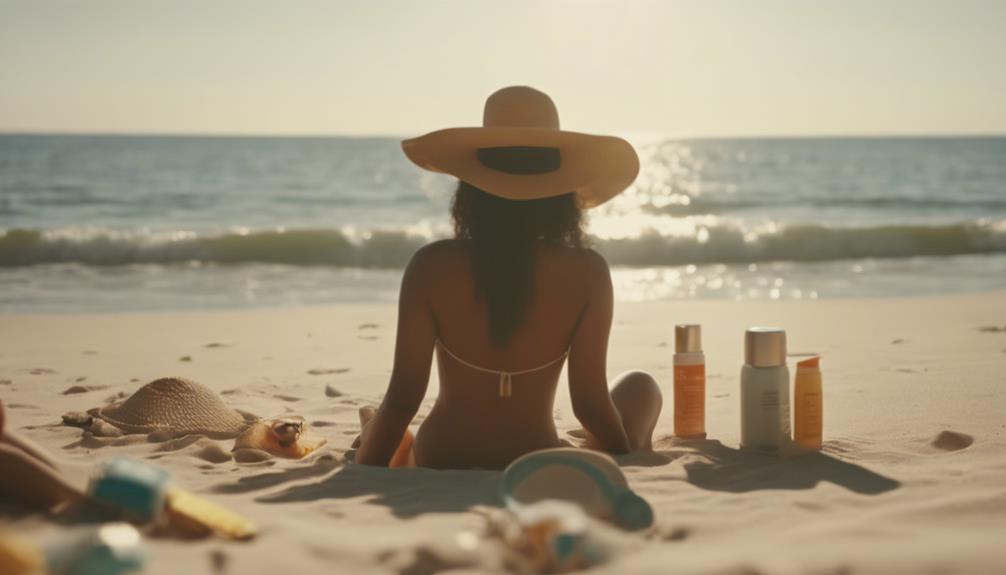
To create the best sun protection routine, start by identifying your skin type. If you have oily skin, use a non-comedogenic, oil-free sunscreen. For dry skin, look for moisturizing options with glycerin or hyaluronic acid. Sensitive skin benefits from mineral sunscreens containing zinc oxide or titanium dioxide. Combination skin needs lightweight, hydrating solutions, while mature skin should opt for products with antioxidants. Apply a broad-spectrum sunscreen with at least SPF 30, generously, and reapply every two hours. Don't overlook protective clothing for extra safety. There's much more to explore on how to fine-tune your sun protection!
Key Takeaways
- Identify your skin type (oily, dry, sensitive, combination, or mature) to choose the right sunscreen formulation.
- Use a broad-spectrum sunscreen with at least SPF 30, applying generously 15-30 minutes before sun exposure.
- For sensitive skin, select mineral sunscreens containing zinc oxide or titanium dioxide to minimize irritation.
- Reapply sunscreen every two hours, especially after swimming or sweating, to maintain effective protection.
Understanding Skin Types
To effectively protect your skin from the sun, it's crucial to understand your skin type, as each one has unique characteristics and needs.
First, identify if you have oily skin, which often appears shiny and may lead to acne. You'll want to choose non-comedogenic and oil-free sunscreen formulations to prevent breakouts.
If your skin feels tight or flaky, you likely have dry skin. In this case, opt for moisturizing sunscreens that contain ingredients like glycerin and hyaluronic acid to help hydrate and nourish your skin.
For those with sensitive skin, reactions to products can lead to redness or irritation. Mineral sunscreens are your best bet, as they typically feature soothing ingredients that minimize irritation.
Combination skin presents a unique challenge, displaying both oily and dry areas. You should look for lightweight, hydrating sunscreens that effectively address both concerns without overwhelming your skin.
Choosing the Right Sunscreen

Selecting the right sunscreen is essential for effectively shielding your skin from harmful UV rays while catering to your specific skin type. Always opt for a broad-spectrum formula with at least SPF 30 to block 97% of UVB rays, providing solid protection against sunburn and long-term skin damage.
If you have dry skin, look for moisturizing sunscreens that include ingredients like hyaluronic acid or glycerin. For oily or acne-prone skin, choose oil-free or mattifying formulations to prevent breakouts. Sensitive skin types should consider mineral sunscreens that contain zinc oxide or titanium dioxide, as these are less likely to irritate your skin while forming a gentle barrier against UV rays.
Additionally, tinted sunscreens can offer broad-spectrum protection while helping to even out your skin tone, making them a great multi-functional option. If you're planning outdoor activities, confirm your sunscreen is water-resistant, allowing for longer-lasting protection during sweating or water exposure.
Don't forget to reapply every two hours to maintain ideal protection, keeping your skin safe and healthy under the sun.
Key Ingredients for Protection

Understanding key ingredients in sunscreens can considerably enhance your skin's protection against harmful UV rays. When choosing a sunscreen, look for broad-spectrum formulas that guard against both UVA and UVB rays. These sunscreens are vital for extensive skin protection and minimizing damage.
For sensitive skin, mineral ingredients like zinc oxide and titanium dioxide are effective physical blockers. They reflect UV rays and are less likely to cause irritation.
On the other hand, if you prefer chemical sunscreens, make certain they include avobenzone to shield against UVA rays. Ingredients like octisalate and octocrylene can also enhance the formula's stability.
If you have oily or acne-prone skin, consider sunscreens with niacinamide. This ingredient not only offers sun protection but also helps regulate oil production and reduce discoloration. However, steer clear of sunscreens containing oxybenzone and octinoxate, as they may irritate your skin and raise environmental concerns, especially regarding coral reefs.
Ultimately, selecting the right ingredients is essential for effective SPF protection tailored to your skin type. Prioritize these key components to guarantee your skin remains healthy and safeguarded from the sun.
Application Techniques for Sunscreen

Proper application techniques can greatly enhance the effectiveness of the key ingredients in your sunscreen, ensuring your skin stays protected from harmful UV rays.
To achieve this, you should apply sunscreen generously, using at least 1 ounce (about a shot glass) for full-body coverage and a nickel-sized amount for your face and neck. Choose a broad-spectrum sunscreen with a minimum SPF of 30, as it provides the necessary amount of protection against both UVA and UVB rays.
For ideal absorption, apply sunscreen 15-30 minutes before sun exposure, making sure to cover all exposed areas, including your ears and the back of your neck.
Remember, no sunscreen blocks 100% of UV rays, so it's essential to reapply sunscreen every 2 hours or immediately after swimming, sweating, or towel drying. This helps maintain your skin barrier against the harmful effects of the sun.
If you wear makeup, consider layering your sunscreen underneath and using setting sprays with SPF for additional protection throughout the day.
These techniques will help you achieve healthy skin while enjoying the outdoors.
Special Considerations by Skin Type

When selecting a sunscreen, it's essential to take into account your specific skin type to guarantee ideal protection and care.
If you have sensitive skin, opt for a physical (mineral) sunscreen containing zinc oxide or titanium dioxide. These ingredients provide broad-spectrum protection while minimizing irritation from fragrances and chemicals.
For dry skin, look for moisturizing sunscreens packed with ingredients like glycerin, hyaluronic acid, or ceramides. These formulations will hydrate your skin while offering a sufficient sun protection factor (SPF).
If you have oily or acne-prone skin, choose oil-free, non-comedogenic options that help control oil and reduce breakouts, ideally with added niacinamide.
For combination skin, lightweight lotions that balance hydration and oil control are your best bet.
Finally, if you're dealing with mature skin, prioritize hydrating sunscreens that include antioxidants like vitamin C. These won't only shield your skin from UV damage but also combat signs of aging.
Long-Term Sun Protection Strategies

To maintain healthy skin in the long run, adopt a consistent sun protection routine that incorporates daily use of broad-spectrum SPF 30 or higher. This greatly reduces your risk of skin cancer and premature aging. Remember to reapply sunscreen every two hours, or immediately after swimming or sweating, as UV rays can penetrate through clouds and water.
Additionally, consider integrating protective clothing, wide-brimmed hats, and sunglasses into your sun protection strategy. These items can provide extra shielding against harmful UV rays. When engaging in outdoor activities, choose water-resistant sunscreens specifically designed to withstand perspiration and water exposure.
Regularly assess your skin for changes; if you notice anything unusual, consult a dermatologist for personalized advice on long-term sun protection strategies tailored to your skin type and concerns.
Here's a quick reference table to guide you in your long-term sun protection journey:
| Protection Type | Recommendations | Additional Tips |
|---|---|---|
| Sunscreen | Broad-spectrum, SPF 30 or higher | Reapply every 2 hours |
| Protective Clothing | Wide-brimmed hats, UV-blocking shirts | Choose light colors |
| Consult a Dermatologist | Regular skin checks | Personalized advice |
Frequently Asked Questions
Which Sunscreen Is Best for My Skin Type?
To find the best sunscreen for your skin type, consider your unique needs. If you've dry skin, choose moisturizing options; oily skin benefits from lightweight formulas, while sensitive skin prefers mineral-based products for less irritation.
Which SPF Sunscreen Is Best for All Skin Types?
Choosing the right SPF feels like finding the perfect umbrella in a rainstorm. A broad-spectrum sunscreen with at least SPF 30 works for everyone, shielding your skin from harmful rays while keeping it healthy and radiant.
How to Find the Right Sunscreen Based on Your Skin Type?
To find the right sunscreen, assess your skin type. If you've dry skin, choose moisturizing options. For oily skin, go oil-free. Sensitive skin needs mineral formulas, while combination skin prefers balanced, lightweight lotions.
What Is the Best Skin Protection From Sun?
Imagine your skin as a delicate flower; without sun protection, it wilts under harsh rays. To shield it, use a broad-spectrum SPF 30 sunscreen, reapply every two hours, and wear protective clothing for extra defense.
Can the Sun Protection Routine for Adults be Applied to Kids to Prevent Sunburn?
When it comes to preventing sunburn in kids, the sun protection routine for adults may not be enough. It’s crucial to use specific remedies for kids’ sunburn, such as sunscreen with a high SPF, protective clothing, and seeking shade during peak sun hours. Keep your little ones safe from harmful UV rays.
Conclusion
Incorporating a tailored sun protection routine into your daily life is essential for maintaining healthy skin.
Did you know that nearly 90% of skin aging is caused by sun exposure?
By understanding your skin type and choosing the right sunscreen, you can greatly reduce your risk of damage.
Remember to reapply regularly and use protective clothing when needed.
Prioritizing sun protection now will pay off in the long run, keeping your skin youthful and radiant for years to come.
-

 Vetted6 months ago
Vetted6 months ago15 Best Tanning Accelerators for a Sun-Kissed Glow This Summer
-
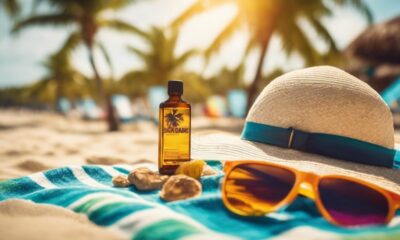
 Vetted6 months ago
Vetted6 months ago15 Best Tanning Oils for a Perfect Sun-Kissed Glow in 2025
-

 Vetted6 months ago
Vetted6 months ago15 Best Sun Tanning Products for a Gorgeous Glow This Summer
-

 Sun Protection6 months ago
Sun Protection6 months agoHow to Protect Your Skin Without Staying Indoors All Day
-

 Sun Protection6 months ago
Sun Protection6 months ago10 Sun Protection Myths Debunked!
-

 Sun Protection6 months ago
Sun Protection6 months agoThe Ultimate Guide to Sun Protection for Every Season
-

 Vetted6 months ago
Vetted6 months ago15 Best Fake Tanning Lotions for a Sun-Kissed Glow All Year Round
-
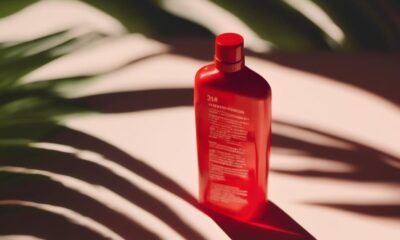
 Sun Protection6 months ago
Sun Protection6 months agoWhat Dermatologists Wish You Knew About Sunburns


